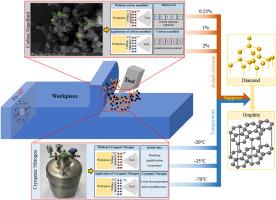Tool wear suppression in diamond turning NAK80 via carbon nanofluids composite cryogenic nitrogen
IF 3.7
2区 工程技术
Q2 ENGINEERING, MANUFACTURING
Precision Engineering-Journal of the International Societies for Precision Engineering and Nanotechnology
Pub Date : 2025-10-02
DOI:10.1016/j.precisioneng.2025.10.001
引用次数: 0
Abstract
Diamond turning is an essential machining method for precision molds and dies. However, iron-carbon chemical affinity leads to severe graphitization of diamond tools when machining iron-based materials. Therefore, it is important to develop new techniques to suppress diamond graphitization. In the present study, an assisted machining method based on carbon nanofluid composite cryogenic nitrogen (CNFCCN) is proposed. Firstly, the influence of different concentrations of carbon nanofluid (CNF) and temperatures of cryogenic nitrogen (CN) on the machining performance was investigated. Secondly, by analyzing the negative effects of CNF-assisted machining at different concentrations and CN-assisted machining at different temperatures on the machined surface quality, CNFCCN-assisted machining at the appropriate concentrations and temperatures were selected, and the effects of CNFCCN-assisted machining on the machined surface quality were investigated. Thirdly, the suppression of graphitization wear of diamond tools by different assisted machining was evaluated by comparing the changes in tool material composition. Finally, the suppression effect of different assisted machining on diamond tool wear was assessed by analyzing the wear width of the flank face. The results show that the machined surface quality is improved by 25.7 % and a 50.9 % tool wear suppression effect is achieved under the machining of 0.25 % CNF composite −20 °C CN. This study provides valuable theoretical and experimental guidance for ultra-precision turning of iron-based materials.

碳纳米流体复合低温氮抑制金刚石车削NAK80刀具磨损
金刚石车削是精密模具的一种重要加工方法。然而,铁碳的化学亲和力导致金刚石刀具在加工铁基材料时出现严重的石墨化现象。因此,开发抑制金刚石石墨化的新技术十分重要。本研究提出了一种基于碳纳米流复合低温氮(CNFCCN)的辅助加工方法。首先,研究了不同浓度的碳纳米流体(CNF)和低温氮(CN)温度对加工性能的影响。其次,通过分析不同浓度cnf辅助加工和不同温度cnf辅助加工对加工表面质量的负面影响,选择合适的浓度和温度cnfccn辅助加工,研究cnfccn辅助加工对加工表面质量的影响。第三,通过对比刀具材料成分的变化,评价不同辅助加工方式对金刚石刀具石墨化磨损的抑制作用。最后,通过分析刀面磨损宽度,评价了不同辅助加工方式对金刚石刀具磨损的抑制效果。结果表明:在0.25% CNF复合材料- 20°C CN加工下,加工表面质量提高了25.7%,刀具磨损抑制效果达到50.9%;该研究为铁基材料的超精密车削加工提供了有价值的理论和实验指导。
本文章由计算机程序翻译,如有差异,请以英文原文为准。
求助全文
约1分钟内获得全文
求助全文
来源期刊
CiteScore
7.40
自引率
5.60%
发文量
177
审稿时长
46 days
期刊介绍:
Precision Engineering - Journal of the International Societies for Precision Engineering and Nanotechnology is devoted to the multidisciplinary study and practice of high accuracy engineering, metrology, and manufacturing. The journal takes an integrated approach to all subjects related to research, design, manufacture, performance validation, and application of high precision machines, instruments, and components, including fundamental and applied research and development in manufacturing processes, fabrication technology, and advanced measurement science. The scope includes precision-engineered systems and supporting metrology over the full range of length scales, from atom-based nanotechnology and advanced lithographic technology to large-scale systems, including optical and radio telescopes and macrometrology.

 求助内容:
求助内容: 应助结果提醒方式:
应助结果提醒方式:


